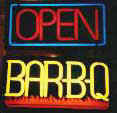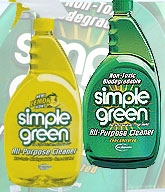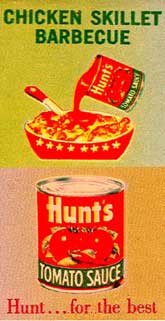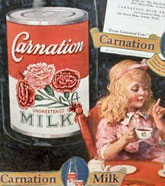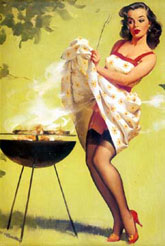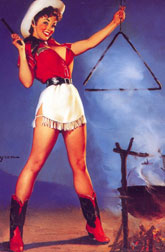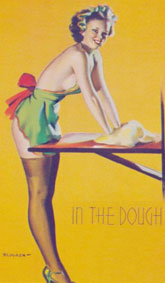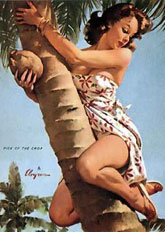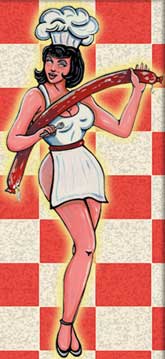Contact BBQbyDan
www.BBQDan.com
Search
KCBS BBQ Cook-Off Info
Recipes,
Smoking Meats
Recipes, Grilling
|
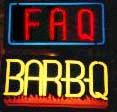 |
FAQ OF THE INTERNET BBQ LIST Version 2.0 Section 10.1.2 We're Smoking Meats Here - Pork Shoulders and Hams |
--------------------
[Can somebody tell me about pork shoulders and how to barbecue them?]
Harry Jiles--
The pork shoulder, which is the entire front leg and shoulder of the pig, is another of the traditional pork barbecue meats. The shoulder, or a portion of it, is usually used for pulled pork barbecue. Pulled pork is meat that is cooked so tender that the individual fibers of the meat can easily be pulled apart with your fingers.
A pork shoulder is tailor made for barbecuing. Pork takes on smoke as readily as any meat there is, and there is enough fat in a shoulder to baste the meat and keep it moist during the long slow cooking process. Yet when the meat is done, almost all of the fat will have been rendered off, leaving wonderfully tender tasty pork. A whole shoulder usually weighs around 12-18 lbs. It might be difficult to find a whole shoulder in a supermarket. You might have to order one or go to a butcher or locker plant to find one. If you can't find a whole shoulder, don't despair. The shoulder is usually cut into two pieces, which are the Boston butt and the picnic. These can be easily found in supermarket coolers.
The Boston butt is from the upper part of the pork shoulder and has the least bone. Yep, you heard right, a pork butt comes from the upper portion of the front leg of the pig. I know that doesn't sound right, but that is the way it is. A butt usually weighs 6-8 lbs. A Boston butt is an excellent choice for pulled pork barbecue.
The picnic is the bonier lower part of the shoulder. It, too, usually weighs about 6-8 lbs. It may have the bone in it or the bone removed and rolled and tied. Both are excellent for pulled pork barbecue, but there is an old saying that the meat nearest the bone is the sweetest, so many barbecuers prefer the bone in. The meat of the picnic has a slightly different flavor than the butt, more like ham.
Following are some general guidelines for smoking shoulders, butts or picnics.
Whole shoulders, butts and picnics can be barbecued "nekid" (no rub or mop) or using your favorite rub and/or mop. Your personal tastes and preferences will have to dictate whether you use a rub or mop or don't mop. Experienced barbecuers can argue for hours about the best method and no one method is right or wrong. I would suggest trying all these methods, over time, and make your own choice about which you like best.
If you use a rub, apply it the night before or at least 8 hours before you plan to cook. Massage the rub into the meat well and place in a plastic bag suitable for food use and refrigerate. Take your meat out of the refrigerator an hour before you start cooking and pat it down with another coat of the rub.
Put the meat into your smoker and cook using indirect heat and a temperature of 200 to 225F. If you use a mopping sauce, mop the meat about every hour. Before cooking, sauces and marinades can be injected into the meat for flavor but they are not necessary for either tenderizing or maintaining moisture.
Use whatever wood you prefer to use. Hickory, oak, apple, maple and pecan are commonly used. Some cooks use a combination of woods for more flavor. The amount of time you keep smoke on your shoulders, butts and picnics is another topic of debate among barbecuers, but I would suggest you keep smoke on the meat for at least 6 hours.
Cook for approximately 1.5 hours per pound. Some barbecuers prefer to finish their meat by wrapping it in foil and putting it back in the smoker for a couple of hours and then unwrapping it. Poke holes in the bottom of the foil so fat and liquids can get away and finish for an hour to firm up the outside crust. Other barbecuers won't ever use foil. Again, this is not necessary and is a matter of taste. Wrapping in foil can give you some added control of moisture, especially if you are cooking several different sized cuts of meat and want them to all come off the cooker at the same time. Be forewarned; when you unwrap a shoulder, butt, or picnic from the foil, the meat will usually be falling apart, so handle it carefully.
Shoulders, butts, and picnics are done when the meat is literally falling apart. Internal temperatures will be 170 to 180F. Very carefully remove your meat from the smoker and let sit 15-20 minutes and then pull it apart. Properly cooked shoulders, butts and picnics should never need a knife to cut up the meat. They should easily pull apart. Remove any remaining fat, gristle and bone.
The pulled meat can be eaten alone or put on a plain white bun and a finishing sauce applied to the meat, which is the traditional pulled pork barbecue method. There are many different finishing sauces and you should try as many of them that you can.
Properly prepared pulled pork barbecue is "to die for" and will win you many friends at a cook-out or reunion. Give it a try.
===============Danny Gaulden--
Pork butts are wonderful cuts of meat to barbecue, and one of my favorites. As so many on the List have said, "they are very forgiving", and a great choice of meat for a novice at barbecue to start with. Why? Mainly because of the fat marbling they have, plus just plain great flavor. If you undercook one just a bit, it may be a little tough, but still eatable; if you over barbecue it, it will still be pretty darn good, and most likely still be moist. Not so with a brisket. Undercooked, it is tough as alligator hide, overcooked it is dry, crumbly, and tasteless. So a butt is a great piece of meat to barbecue in a larger cut. Plus it's not very expensive.
Choosing a butt is not that difficult. Most come in the 6 to 9 lb. range. I like 'em about 7 lbs. or so. A nice fat cap of about 1/4 to 1/3 inch is good, and try to pick one with some marbling in the meat itself. Sometimes butts can be too fat, so be careful. You want a fat cap and marbling, but not too much.
I like to start it out the same as a brisket. Generously apply a rub on it, wrap in clear wrap, place in refrigerator overnight, and barbecue it the next day. Set the butt out of refrigerator about 30 minutes before putting it in the smoker, while you're building the fire in your smoker. Re-work the rub into butt while waiting for fire to get up to temperature. If you don't want to use any additional seasonings at this point, fine. Most do, some don't.
When the smoker temperature reaches 230 to 235F, place the butt in the smoker fat side up and smoke until extremely fork tender. Putting it fat side up lets the natural fat juices work over and through the meat and acts as a natural mop. As with smoking ribs, I have found that if I'm using an off-set firebox smoker, I need to turn the meat. For a pork butt or picnic, turn and mop it every two hours. If you're using a water smoker, you can leave it fat cap up all the time, just mop it every two hours. I like to smoke at 240 to 250F constantly. This generally takes about 70 minutes a pound, or 8 1/2 to 9 hours for a 7 1/2 pound butt.
The pork butt should come out of the smoker when it is "fork tender". Not long ago, I measured the internal temperature of a bunch of pork butts smoked in my commercial smoker. Here's is what I found:
For a sliceable pork roast, take it out at 180F.
For a sliceable and pullable roast, take it out at 185F.
For an easily pullable roast, take it out at 190F.
After you take it out of the smoker, let it cool for 30 minutes or so. DO NOT fork the butt in the fat area to check for doneness. This will be misleading, for the fat will become tender way before the meat (muscle) around the bone area. Always check for doneness in the meat area under or around the bone. If you are not going to eat the butt within the first hour after barbecuing, double wrap it in foil, set it in a non-drafty area, or a small ice chest (no ice in chest), and let sit until it's time for dinner. As long as the butt stays between 140 to 160F internally, it will not spoil. Check with a meat thermometer every once in awhile, or stick thermometer into meat after wrapping in foil so that you can periodically monitor the internal temperature.
Sometimes I like to apply a finishing glaze on the butt as soon as it comes off the smoker. It is the same one I use on my ribs, and has become very popular with many folks on the List. As soon as the butt is off the pit, baste it once with the glaze. Then let it stand a couple of minutes, and baste again. Then either let the pork sit a few minutes before preparing it for the table (you don't want to cut it while it is too hot, for it will be difficult to handle, and turn brown), or store as stated above.
Smoking times will vary depending on how accurate a fire tender you are, how often you open your smoker to take a peek, and the natural tenderness of the meat in the raw state. These times are just general guidelines and will most likely vary every time you barbecue.
--------------------[I've heard that many chefs are now serving pork pink. My mother always told me to cook pork until it is well done. What's the story here?]
Harry Jiles--
This section answers questions and concerns that some persons have on internal temperatures for safely cooking pork.
Many people still basically overcook their pork because of fears of trichinosis, so let's get the facts straight on that matter first. It is highly unlikely that trichinae would be present in today's commercially-produced pork. Trichinae could be present in wild animals, but even with them, it is still a rarity. You have a higher probability of choking to death on a piece of commercially-produced pork than you do of contracting trichinosis from it. Even in the highly unlikely event that trichinae were present in a piece of pork, they would be killed at an internal temperature of 137F. This is well below the recommended internal temperature of 160F from the National Pork Producers Council (NPPC).
As I stated above, the NPPC recommends an internal temperature of 160F. Pork cooked to this temperature will still be pink inside and the juices will run clear if it is pierced with a fork. Do not be afraid of pork that is still pink. Pork that is still pink in the center will be much juicier and flavorful than overcooked pork. The 160F temperature is recommended to kill bacteria that might be present on the meat. Since almost all of any bacteria that might be present would be on the surface of the meat, if it is not ground meat, you actually do not always have to cook to 160F for safety and, in fact, some cooks only cook pork to around 140F. If the cut of meat has been properly handled and stored so that there is no excessive growth of bacteria on the meat, this practice is perfectly safe and acceptable and actually preferred by many people.
Keep in mind that the internal temperatures that we are talking about above are mainly for naturally lean and tender cuts of pork, such as the loin and loin chops. These cuts do not really need the long slow barbecue cooking process to tenderize them and can actually suffer in quality if cooked as long as you would cook other traditional barbecue cuts of pork. They are best taken off as soon as they reach the above mentioned temperatures so they will not be too dry.
To recap the proper temperatures for safety: Always cook ground pork to 160F to kill any bacteria in the meat. If you are concerned about bacteria in cuts of pork, cook to 160F. If you are grilling or smoking pork loin or loin chops, and you want them as juicy and flavorful as possible, and they have been stored and handled correctly so bacterial growth is not a concern, cook them to 140F.
--------------------[When I do a full pork shoulder or picnic shoulder, do I take the skin off or leave it on? Should I baste or mop it?]
Dave Lineback--
Baste a shoulder (picnic)? Blaspheme! Why? The shoulder itself contains all the flavorings needed. Use of a mop made by man will only detract from the flavor. Leave the skin on and leave it alone!
===============Rocky Hurley--
Here, Here! I agree with Dave on this! Leave the skin on and barbecue it naked. It don't need anything else! If you want to make it taste different, do that with the sauce, slaw, salad, tea, or dumping spices directly on your tongue, but don't ruin a perfectly good piece of meat!
Editor--Dave and Rocky are a couple of North Carolina country boys that know a thing or two about making traditional NC-Style pulled pork. Use a rub or not as you choose, but the majority of BBQ List members like to leave the skin on a full or picnic shoulder.
--------------------[I really like the 'bark' on the outside of the meat I'm smoking. Anybody know how to get more of this stuff?]
Danny Gaulden--
I ran a test on the butterflied butt for all you 'bark' lovers. Raw weight of bone-in butt was right at 8 lbs. After removing the bone, the butt weighed 7 1/4 lbs. Bone weighed 3/4 lbs. After removing the bone, you have a large gap in the meat, so just continue cutting across until you almost get to the other side (end). Make sure you don't cut all the way through, or you'll end up with two pieces (guess it really wouldn't matter). I gave the meat a good rub with my general purpose dry rub. I smoked the butt at 230-250F, and I took it out of the smoker after 6 hours and 35 minutes. No foil. The internal temperature was 180F in the most solid part of the muscle. Notice, I didn't stick the thermometer into a fatty area for my reading. The meat was very tender, with lots of bark on both sides, and was pretty neat looking. I guarantee that you will get lots of bark, and a great-tasting smoky piece of meat if this is what you are after.
Some facts again: Raw butt weighted 8 lbs. with bone in. With bone removed, butt weighted 7 1/4 lbs. After barbecuing, meat weighted 4 1/4 lbs. After-cooked yield weight would equal: 53% before bone was removed, 59% after bone was removed. Hints: If you haven't had a little practice de-boning a pork butt, don't be afraid to try it. Just get in there and do it. If you leave too much meat on the bone, just remove it after bone is out, and place it on the cut side of the butterflied butt (the side of the meat that will be facing down as you smoke it). All the meat will seal together as it cooks, and you'll never know you "put it together". This happened to me a few times during my early days.
--------------------[I'd like to know what the ramifications are from cutting up a large roast into smaller pieces to decrease cooking time. If doing a 10 pound Boston butt, it takes an hour and a half per pound, that would be approximately 15 hours. But now if I quarter this into 2 1/2 pound sections, and cook them all at once, would this cut my cooking time down to approximately 3 1/2 hours?]
Ed Pawlowski--
There is cooking until the meat is "done" and there is cooking until you make 'barbecue'. Meat is done when the temperature reaches 145 to 170F, depending on what you are cooking and how you like it internally. Barbecue is not just getting the meat to temperature, it is a process of breaking down the collagen so the meat tenderizes. This takes time. You can play with some temperature/time combinations, but you still need a lot of time.
Cooking the smaller pieces will let them dry out too fast while the meat remains tough. The larger pieces act as insulators and moisture barriers.
===============Editor--
You can use Rick Day's foil method to cut down the time needed in the smoker. Cook the butt for 6-8 hours in the smoker at 235-250F. Remove the butt from the smoker and wrap it in several layers of aluminum foil. Wrap the foiled butt in a few old bath towels for insulation and then put the meat into a small ice chest (no ice). This process will keep the butt hot for another 5-6 hours and the meat will keep cooking. You can use the same technique with brisket. The downside is that the bark is not crispy.
--------------------[Can you tell me some more about making authentic Eastern North Carolina Pulled Pork?]
Tom Solomon--
I'm originally from North Carolina but now live in Virginia. I grew up in Greensboro about a mile from Stamey's Pit-Cooked Barbeque restaurant (Lexington style barbecue) but later in life became a convert to Eastern North Carolina style barbecue (apple cider vinegar and red pepper).
While this is hardly definitive, this is how I do it.
Tom's Eastern North Carolina Style Barbecue
First, get yourself some pork shoulders or Boston butt roasts, as many as your smoker will hold comfortably. I use a Brinkmann SnP Pro. It has an off-set firebox, but you can do this with a vertical water smoker as well. The key is providing a moist, smoky, indirect heat for a long period of time.
What I do is put a bag of charcoal in the firebox, open the vents, light it, and let it burn down to coals. Then I add wood (generally oak, since hickory is scarce up here)--two parts wet (soaked) wood to one part dry--regulate the dampers, and put the shoulders or butts, fat side up, in the cooking chamber. Beneath the meat I put a drip pan half-filled with apple cider vinegar. You must keep the heat between 180-260F throughout the smoking process; the optimum range is 220-240F. Normally, I'll add apple wood to the firebox as well, and I always add between 5-7 whole heads of garlic during the process. Keep the firebox fed and a good smoke going for between 8 to 10 hours. Do not open the cooking chamber to baste the meat--the only time you open the cooking chamber is when the temperature spikes above 260F, and you open it only long enough to bring the temperature back in the proper range. By the time the smoking period is finished, the outside of the pork will have a golden amber to dark-brown crust.
Now, take the meat and put it in a covered Dutch oven. If it's too dark outside to continue, preheat your indoor oven to just under 300F; otherwise, just raise the temperature in the cooking chamber a like amount. Get a quart-sized Mason jar; fill it halfway with apple cider vinegar, add one (or more) teaspoons of red pepper flakes, and fill the rest of the jar with water. Dump this into the Dutch oven with the pork, cover, and cook until the meat falls from the bone, about 2 more hours or so.
When the meat is done, let it cool a bit. (If you're too tired, you can stop here for the day--cover 'em up, put them in the refrigerator, and warm 'em up the next morning and continue the procedure.) While it's cooling, fill some 16 ounce bottles with apple cider vinegar, adding about a teaspoon of red pepper flakes to each one (I use Grolsch beer bottles with those pull-down caps). When the pork has cooled enough to handle (I use latex gloves) pull it into thumb-sized chunks, discarding as much fat as possible. Pack roughly 3 pounds of barbecue into a large frying pan (I use a Number 10 size cast iron skillet). Dissolve 1 tablespoon of salt into 2 1/2 cups of warm water and pour it into the pan. Add about 12 ounces of your apple cider vinegar and red pepper sauce, turn the heat to medium, and let the liquid slowly simmer off, stirring frequently, until the sauce just barely oozes over the top of your spatula when you press down on the barbecue with it. Remove from heat, and congratulate yourself--you've just made a fine batch of Eastern North Carolina Style Barbecue.
--------------------[Can someone tell me how to make authentic Lexington North Carolina-style pork?]
Dave Lineback--
Making barbecue is one of the most simple forms of cooking. It has been going on since prehistoric times. Here's how you do it:
1 Burn some hardwood down to coals.
2 Place a tough cut of meat over the coals and cook until tender.
3 Pull out a hunk of meat, add a little finishing sauce if you like, and enjoy!
When you burn a hardwood like hickory or oak down to coals, the "bitter" components of the smoke are burned off in the flame. What remains is a thin, sweet smoke coming from the coals that is almost invisible to the eye. This is the smoke that produces the characteristic pink aurora in the surface of the meat that gives barbecue its distinctive flavor. I do not believe it is possible to get too much of this smoke in the meat. Without it, the meat is nothing more than a roast. That's why every barbecue joint worth its salt has a separate hearth for making the coals that are subsequently picked up in a shovel and placed under the meat in the pits. While you might see a ton of white smoke coming from the hearth chimney, you will seldom see anything coming from the chimneys above the pits. But you sure can smell it!
So much for the one and only really important thing about barbecue. All the rest is window dressing. The question of how long to cook is primarily a question of time and temperature. Temperature is a function primarily of distance from the coals and air circulation. (The word barbecue itself derives from the name of the wooden structure the West Indians used to suspend meat over coals for cooking.) Tough cuts of meat like beef brisket take a very long time for the connective tissues to break down. Therefore, very low temperatures are in order. Pork takes less time.
I am amused by the protracted daily discussions on this BBQ List about thermometers. Barbecue is an art, not a science. Pitmasters may argue a lifetime over whether the racks should be 16 or 18 inches above the coals, but I have never visited a pit in which a thermometer was used! Most of them have no idea what the temperature is. Oh, they might touch a door with the palm of their hand. More likely they are going to be studying the wood, the outside temperature, the humidity, etc. Like my golfing buddy sez about my collection of putters, "It ain't the fiddle, its the fiddler!" Some truly great barbecue can be made on an old set of bed springs held over a bed of coals by cinder blocks at the corners.
Most folks like to push their barbecue in a particular direction with a little finishing sauce. That's okay so long as it does not mask the barbecue flavor. Of course, if the meat was roasted in a gas grill or some other such "oven on wheels" that produces no wood smoke at all, a strong finishing sauce will be necessary to emulate a barbecue "taste". That stuff might be good to eat, but, folks, please don't call it barbecue!
Editor--See Dave's Web page for more details, and recipes and especially photos of his
homemade outdoor Lexington-styled smoker, "Wilbur". ![]() Click here to go to Dave's Web page.
Click here to go to Dave's Web page.
[What type of roll do I use for NC-style pulled pork sandwiches--French?]
Tom Kelly--
No! Not if you are going for the traditional, North Carolina style barbecued pulled pork sandwich with a light vinegar-based sauce. It is meant to be eaten on a plain, white, slightly-sweet hamburger bun. Nothing else is an acceptable substitute if tradition is your goal. However, that said, my wife and I have become fond of pulled pork, with a light vinegar based sauce, on a whole grain wheat roll made by a local supermarket bakery.
--------------------[Whenever I smoke a pork shoulder, picnic or butt in my NBBD, the bark on the outside of the meat comes out black after 10-12 hours. Is the black caused by the sugar in my rub caramelizing?]
Belly--
It be the sugar that makes the meat black.
===============Jim Anderson--
I have a SnP Pro and never use sugar in my pork shoulder rubs. The very dark color you see is the result of the sugar (white/brown) caramelizing. The shoulders I do come out of the pit a reddish golden brown color. I leave them in for 12 hours at 200/225F. If I leave them longer, I foil wrap them after the internal temperature reaches 185F and reduce the cooking chamber temperature to 150/175F.
===============Kurt Lucas--
The bark on my butts and briskets is exactly the way yours are, black, but with no burnt taste. I've always thought it was the way it was supposed to be.
===============Danny Gaulden--
I agree with Kurt, nothing wrong with a black bark on a shoulder. As a matter of fact, a lot of ol' Texas pitmasters wouldn't have it any other way.
===============Wayne Beyer--
I found that regular sugar blackened up fast and got hard and too crusty on a picnic or brisket. I switched to turbinado sugar and didn't have this problem anymore.
--------------------[OK. I smoked my pork butt, but how do I 'pull' it? Into what size pieces do I pull or chop it?]
Wyndell Ferguson--
The way I pull pork is to take two large carving forks and just rake across the meat in opposite directions. I then take my cleaver and chop the pulled pork into pieces about 2 inches long. Also, I have found it pulls easier if I cut Mr. Brown off, along with any remaining fat cap. I place these off to the side. I put all the inside meat into a large bowl. I then take Mr. Brown and chop into pieces about 1/2 by 1/2 inch (sometimes smaller) and mix into the inside meat very well. I then mix in some of my Mustard Vinegar sauce (not a lot, just enough to wet it all down). Normally when I do pork, I cook something along with it for that day, and we have the pork the rest of the week.
The fat cap with all the Mr. Brown on it I freeze to use for beans. I chop it into pieces about the size of what I will use in a pot of beans and freeze it. This way I can just pull out what I need to do a pot.
Fergy's Mustard - Vinegar Barbecue Sauce
Amount |
Measure | Ingredient | Preparation Method |
2 |
cups | cider vinegar | |
1 |
cup | yellow prepared mustard | |
2 |
tablespoons | black pepper | finely ground |
1 |
tablespoon | Worcestershire sauce | |
1 |
cup | brown sugar | packed |
3 |
tablespoons | Louisiana style hot sauce | or Texas Pete |
1/2 |
tablespoon | seasoned salt |
Mix together and store in jar or squirt bottle. Gets better as it ages!
===============Jeff Lipsitt--
I've seen pork pulled all ways. Some folks shred it with sauce so it's almost as tight as angel hair pasta in tomato paste. Others prefer to pull it in larger pieces for a different consistency. Personally, I like it shredded tiny when I have it on bread with coleslaw. On a plate, I prefer it in larger chunks.
--------------------[I'd like the recipe for a red sauce and a mustard sauce to use with pulled pork.]
Don Martin's Pork Red Sauce:
Amount |
Measure | Ingredient | Preparation Method |
14 |
ozs | tomatoes | crushed |
1 |
small | onion | minced |
1/8 |
cup | honey | |
1/4 |
cup | molasses | |
1/8 |
cup | cider vinegar, amber | |
1 |
cup | ketchup | |
1 |
tablespoon | garlic | minced |
3 |
tablespoons | lemon juice | |
1 |
tablespoon | Worcestershire sauce | |
1 |
tablespoon | Frank's Louisiana hot sauce | |
1 |
tablespoon | chili powder | |
1/2 |
tablespoon | powdered mustard | |
1 |
teaspoon | salt |
Bring ingredients to boil, than simmer 1 hour. Refrigerate until used. I heat it up before I mix it into the pork.
===============Don Martin's Yellow Sauce:
Amount |
Measure | Ingredient | Preparation Method |
4 |
cups | cider vinegar | |
1/4 |
cup | honey | |
2 |
tablespoons | yellow mustard | like French's prepared |
4 |
tablespoons | brown sugar | |
4 |
teaspoons | salt | |
2 |
teaspoons | black pepper | coarse grind |
4 |
teaspoons | pulverized red pepper flakes | like for pizzas |
Heat ingredients in saucepan for 30 minutes. I heat this up also before putting it on the pork.
--------------------
[I'm trying my first whole ham (not cured) in the smoker overnight. Any thoughts on this?]
Danny Gaulden--
Cut off the skin (this lets the smoke penetrate more), but leave the fat. Put a basic rub on it. If you don't have one handy, some salt, pepper, and a little garlic will work just fine. Cook slow at 220-225F, and keep the smoke going fairly often. I like to barbecue mine until the internal temperature reaches 175F or higher. Remember, this isn't as lean as a pork loin, so you can go to a higher temperature. Makes it really tender if you bring it up easy. About 30 minutes before it's done, baste a couple of times with my rib glaze.
===============
Harry Jiles--
I had the shoulder portion of a couple of fresh hams (10 lbs. each) in the freezer that I needed to use. Since the hams were very lean, I decided to inject them with marinade. I decided to try something different.
Souvlakia Marinade
Amount |
Measure | Ingredient | Preparation Method |
2 |
cup | olive oil | |
| juice of 2 limes | |||
6 |
cloves | garlic | |
4 |
teaspoons | oregano | |
1 |
teaspoon | thyme | |
1 |
cup | lemon juice | |
1 |
cup | red wine | |
4 |
teaspoon | salt | |
2 |
whole | bay leaves | |
1 |
teaspoon | fresh ground pepper | |
1 |
cup | water |
I blended the marinade well in the food processor and let it sit in the refrigerator for 24 hours for the flavors to blend. I took half of the marinade and strained it and injected it into the two hams, about 1 1/2 cups in each one.
Then I rubbed the hams with this rub.
Souvlakia Rub
Amount |
Measure | Ingredient | Preparation Method |
1/2 |
cup | olive oil | |
3 |
cloves | garlic | minced |
2 |
teaspoons | salt | |
2 |
teaspoons | oregano | |
1 |
teaspoon | black pepper | freshly ground |
I let them sit overnight in the refrigerator and then took them out to come to room temperature. I cooked them in the smoker at 250F, using seasoned maple for fuel. I started mopping with the remainder of the marinade after 4 hours in the smoker, mopping about every hour. Took them out after 12 hours, wrapped them in foil and let them sit for 2 hours in a dry cooler.
They really turned out well. The injected marinade kept them moist and they were falling apart tender. Great flavor! The maple smoke blended quite well with the souvlakia marinade flavor.
===============
Wyndell Ferguson--
A fresh ham is smoked about the same as a pork shoulder. I like to trim the skin and fat off (not all, but leave about 1/4" fat on it) leaving about 3" of skin along the shank portion. Put a dry rub on the night before and wrap in plastic wrap. Let it sit in the refrigerator overnight. This will help draw the moisture from the top layer and turn the rub into a gel. Before putting it on the smoker I put a light coat of vegetable oil over the ham, then I put on more rub.
Start the smoking at a lower temperature than usual, around 225F, and a little heavier smoke. After 1 to 1 1/2 hours I baste with an oil-based mop, and again at 3 hours. After that I mop every hour with a apple juice and vinegar mop. After the second oil-based mop, I move the temperature of the smoker up to about 250-275F until the ham is fall-apart tender (1 1/2 hours per pound or an internal temperature of 185-190F.) Let the meat sit for about 30 minutes wrapped in foil. Pull the ham apart and put some sauce on it. I like my Mustard Vinegar sauce. I add just enough sauce to keep the meat moist when I reheat it. When I serve it, there isn't much evidence of the sauce, and I serve the ham with sauce on the side. To reheat, I put the meat in a Ziploc bag that is closed about 2/3-3/4 of the way, add some Worcestershire sauce, a sprinkle of rub and maybe a splash of cider vinegar. I reheat in the microwave in 1 minute increments, mixing the meat thoroughly after each minute until it's hot. This helps trap moisture, keeps the meat from drying out and heats the meat quickly!
--------------------
[I want to do a cured ham in my smoker for Easter. Anybody got any ideas on the best way to do it?]
Danny Gaulden--
If you're doing a bone in, cured ham, here is a good way to finish it. Most hams of this style are sold skinned in most areas, but will have a few sections where the skin (hide) is still on. Especially around the tapered end going toward the end of the bone. Cut the skin off with a good sharp knife, being careful not to cut or remove the fat under it.
You're not really concerned about deep cooking since this type of ham is actually already cooked. What you are interested in is giving it a better and richer flavor. Therefore, you don't need a very hot fire, but a low to medium one with good smoke. The reason I like to keep a medium heavy smoke going is because the meat won't be on the smoker that long, compared to a raw ham. The reason I like a low-to-medium heat is to extend the smoking time a bit.
Bring smoker up to about 225-230F and try to keep it in that range. Make sure you have an oven thermometer placed about an inch or two away from the ham. This will guarantee accuracy. Smoke the ham until it reaches about 150F, no higher than 160F internally. Use my mustard glaze for the outside of the ham (Section 9.4). Baste the ham with the glaze at 30 minutes, then again at 15 minutes, before ham is ready to be removed from smoker. If you like, you can baste one more time with the glaze as soon as it comes off the smoker. As an added treat, you can add pineapple rings and maraschino cherries on top of the ham about 30 to 45 minutes before it's done. You can hold these down with toothpicks.
You can download all the recipes in this FAQ ![]() Click here
Click here
Go to the next section
Return to the Table of Contents
Return to the BBQ FAQ Home Page
Comments or Suggestions
BBQ FAQ Ver 1.0, 2.0 ©1997, 1998 William W. Wight. All rights reserved.

